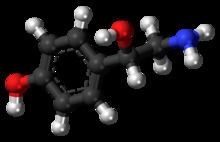Routes of
administration Oral Molar mass 153.178 g/mol Bioavailability 99.4% | ATC code C01CA18 (WHO) CAS ID 104-14-3 | |
 | ||
Legal status Rx / Uncontrolled / Banned by World Anti-Doping Agency Metabolism Biological half-life 15 minutes in insects. Between 76 and 175 minutes in humans Excretion Up to 93% of ingested octopamine is eliminated via the urinary route within 24 hours | ||
Octopamine (molecular formula C8H11NO2) is an organic chemical closely related to norepinephrine. In many types of invertebrates it functions as an important neurotransmitter and hormone, but in the human body it normally exists only at trace levels and has no known function. Because it shares some of the actions of norepinephrine, octopamine has been sold under trade names such as Epirenor, Norden, and Norfen for use as a sympathomimetic drug, available by prescription. Very little information exists concerning its clinical usefulness or safety.
In mammals, octopamine may mobilize the release of fat from adipocytes (fat cells), which has led to its promotion on the internet as a slimming aid. However, the released fat is likely to be promptly taken up into other cells, and there is no evidence that octopamine facilitates weight loss. Octopamine may also increase blood pressure significantly when combined with other stimulants, as in some weight loss supplements.
